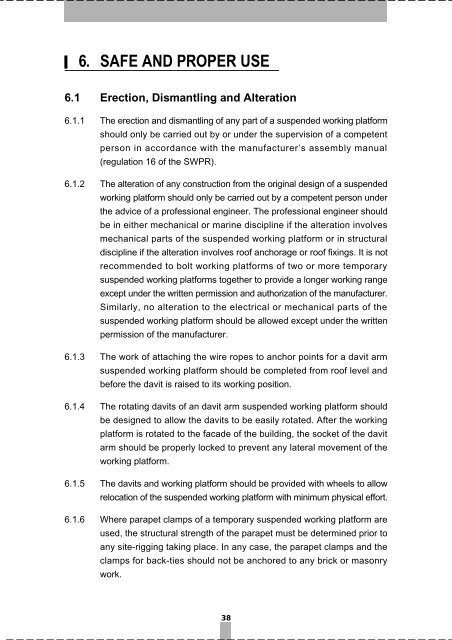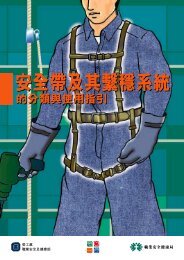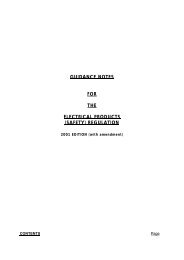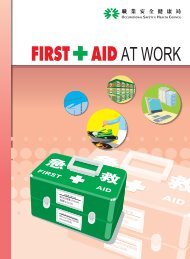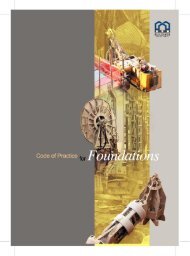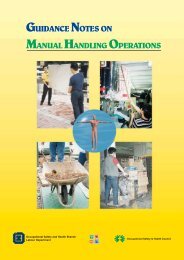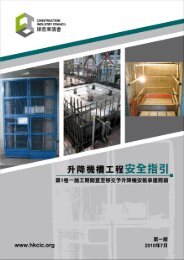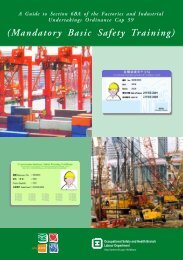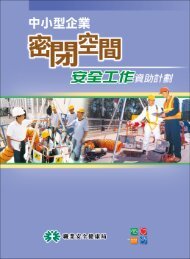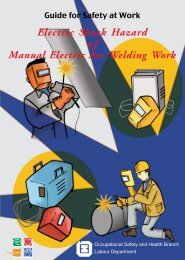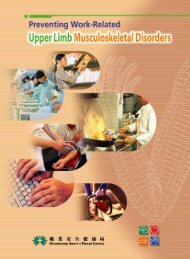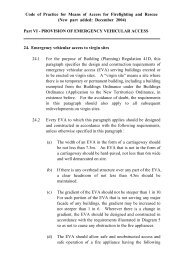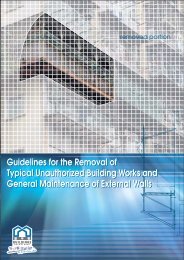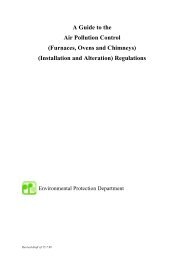Code of Practice for Safe Use and Operation of Suspended Working ...
Code of Practice for Safe Use and Operation of Suspended Working ...
Code of Practice for Safe Use and Operation of Suspended Working ...
- No tags were found...
You also want an ePaper? Increase the reach of your titles
YUMPU automatically turns print PDFs into web optimized ePapers that Google loves.
6. SAFE AND PROPER USE6.1 Erection, Dismantling <strong>and</strong> Alteration6.1.1 The erection <strong>and</strong> dismantling <strong>of</strong> any part <strong>of</strong> a suspended working plat<strong>for</strong>mshould only be carried out by or under the supervision <strong>of</strong> a competentperson in accordance with the manufacturer’s assembly manual(regulation 16 <strong>of</strong> the SWPR).6.1.2 The alteration <strong>of</strong> any construction from the original design <strong>of</strong> a suspendedworking plat<strong>for</strong>m should only be carried out by a competent person underthe advice <strong>of</strong> a pr<strong>of</strong>essional engineer. The pr<strong>of</strong>essional engineer shouldbe in either mechanical or marine discipline if the alteration involvesmechanical parts <strong>of</strong> the suspended working plat<strong>for</strong>m or in structuraldiscipline if the alteration involves ro<strong>of</strong> anchorage or ro<strong>of</strong> fixings. It is notrecommended to bolt working plat<strong>for</strong>ms <strong>of</strong> two or more temporarysuspended working plat<strong>for</strong>ms together to provide a longer working rangeexcept under the written permission <strong>and</strong> authorization <strong>of</strong> the manufacturer.Similarly, no alteration to the electrical or mechanical parts <strong>of</strong> thesuspended working plat<strong>for</strong>m should be allowed except under the writtenpermission <strong>of</strong> the manufacturer.6.1.3 The work <strong>of</strong> attaching the wire ropes to anchor points <strong>for</strong> a davit armsuspended working plat<strong>for</strong>m should be completed from ro<strong>of</strong> level <strong>and</strong>be<strong>for</strong>e the davit is raised to its working position.6.1.4 The rotating davits <strong>of</strong> an davit arm suspended working plat<strong>for</strong>m shouldbe designed to allow the davits to be easily rotated. After the workingplat<strong>for</strong>m is rotated to the facade <strong>of</strong> the building, the socket <strong>of</strong> the davitarm should be properly locked to prevent any lateral movement <strong>of</strong> theworking plat<strong>for</strong>m.6.1.5 The davits <strong>and</strong> working plat<strong>for</strong>m should be provided with wheels to allowrelocation <strong>of</strong> the suspended working plat<strong>for</strong>m with minimum physical ef<strong>for</strong>t.6.1.6 Where parapet clamps <strong>of</strong> a temporary suspended working plat<strong>for</strong>m areused, the structural strength <strong>of</strong> the parapet must be determined prior toany site-rigging taking place. In any case, the parapet clamps <strong>and</strong> theclamps <strong>for</strong> back-ties should not be anchored to any brick or masonrywork.38


